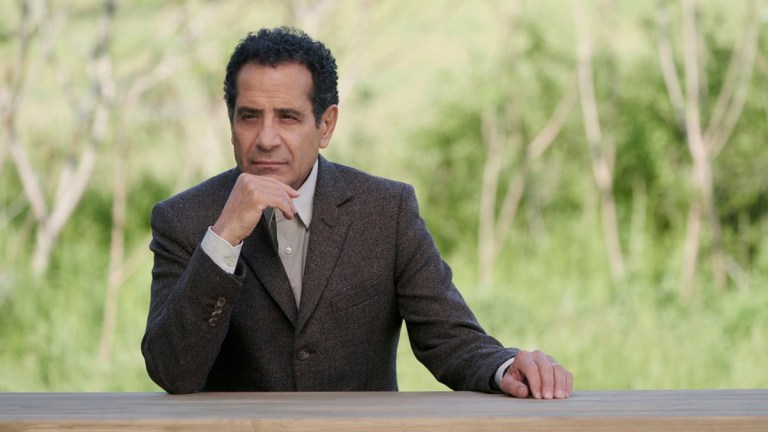Monk Has Aged Surprisingly Well … With Some Exceptions
With all eight seasons of Monk now on Netflix, it's time to realize that the titular detective could have used some better friends.

Fans of bingeable mystery shows are in for a treat: all episodes of Monk are now available to stream on Netflix! The USA Network original series centered around Adrian Monk (Tony Shalhoub), a former investigator for the San Francisco Police Department whose wife’s death exacerbates his OCD, along with his multiple phobias. However, his keen attention to detail makes him a valuable private detective consultant for the force, and he’s called in to help solve unconventional cases. The show won eight Emmy Awards and was notable as one of the early representations of a person with OCD as the protagonist of a series.
In addition to its appearance on Netflix, the show received a movie on Peacock in December 2023. It’s not often that a writer gets to go back and re-imagine what he might have done differently if he were writing a show for a modern audience, but series creator Andy Breckman recently had that chance with Monk, which aired 2002-2009. Preparing for the film gave Breckman a chance to revisit the series. In a USA Today interview, he acknowledged that while still being proud of the show, “20 years ago, I didn’t make the (writing) decisions I would now.”
Though critics noted the movie had a slightly darker feel than the original, more light-hearted series—Monk, like the audience, has to deal with COVID and its consequences—it did give viewers a peek into what Monk might have been like if it were written for an audience with a greater understanding of mental health.
What Monk Did Well
The original series wouldn’t have lasted eight seasons if fans hadn’t loved the character of Monk. Much of this is absolutely due to Shalhoub’s charisma in the role: he performs the character in an endearing way, and his phobias and quirks add to that charm.
Adrian Monk is presented as a character who has always been neurodivergent, but the unsolved death of his wife—which is finally solved at the end of the series—causes Monk to become even more vulnerable to his OCD and phobias. The series begins when Monk has not left the house for three years. He has a nurse aide assisting him at all times, because he’s unable to care for himself alone. He also has a therapist whom he has sessions with regularly, and it’s during those sessions that Monk is shown at his most vulnerable.
Despite the heavy character background and the murders being solved, Monk is frequently played as a comedy—Shalhoub actually won the lead actor Emmy three times in the comedy category, against stars of sitcoms. While Monk’s behaviors are played for their humor value, there’s no sense of the audience laughing at Monk. They’re laughing because the situation Monk’s behaviors cause might be ridiculous, but they love him, as a character, through it all.
There are elements of his character that are more sympathetic to a modern audience, as well. Looking at the character almost fifteen years after the show ended, Shalhoub told a Parade magazine interviewer, “If people watch [Monk] in reruns during and after the pandemic, he’s not gonna look so neurotic anymore. He’s going [to] look more like the canary in the coal mine.” In a post-pandemic world, where the reality of germs cost so many people so much, the depiction of Monk and his phobias rings much closer to home.
What Wouldn’t Work About Monk Today
When Monk first aired, Monk was billed as “Obsessive Compulsive Detective” and “the defective detective,” terms that surely would not hit the same note with modern viewers. Audiences in 2024, especially members of Gen Z, are far more aware of mental health issues—and have more frank discussion about their own mental health—than the majority of viewers in the early 2000s. Considering someone with OCD “defective” just doesn’t fly.
Some psychologists took issue with the presentation of OCD on the show over a decade ago—after the show was off the air, but well before the pandemic shaped conversations about mental health and germs. Fletcher Wortmann in Psychology Today wrote about one particularly egregious episode, the Emmy-nominated “Mr. Monk Takes His Medicine,” in which Monk finally agrees to be medicated for his OCD and is immediately cured. “Sadly, use of the medication comes at a terrible price … Monk’s medication totally changes his personality — nuMonk is abrasive, egocentric, and oblivious to social cues.”
He also completely loses his crime fighting superpowers, because he no longer has his OCD to make him pay attention to the details. (This falls into the “Magical Disabled Person” trope, where a character’s seemingly superhuman abilities are due to their disability, and they must therefore suffer or lose what makes them special.) Obviously, medicine doesn’t work that way, and OCD doesn’t work that way either.
Monk’s Friends Were the Problem
Viewers of the show with OCD have had mixed reactions to whether Monk offers good representation. In some cases, the fact that there was representation with a positive character, rather than a villain, was enough to forgive any flaws. Others saw their own issues well-shown on the screen, without lingering too long on moments of anxiety or introspection.
One of the larger issues on the show that would likely be handled differently today is the way others responded to Monk’s behaviors. Some of his supposed friends reacted constantly with frustration, tolerating Monk rather than supporting him. While this behavior is true to what many neurodivergent people experience, that the show itself never offers a critique on this tolerance suggests that greater understanding isn’t needed. A new incarnation would be more likely to show friends who truly act as friends, loving Monk with support and kindness rather than just tolerating him.
Another issue is the way that, rather than helping Monk deal with his phobias, his assistants provide him with negative coping mechanisms. Mary Sue contributor Sarah Barrett, who has OCD, pointed out how much better Monk would have managed with Exposure and Response Prevention Therapy, which was already well known when the show was being produced. “Whenever I watch Monk, I do get feelings of, ‘Monk’s assistants are making life so much worse for him, my god,’” Barrett explained.
An updated version of the show would be more likely to focus on teaching Monk to manage—and cope—with the anxieties of his OCD, rather than just playing off many of his behaviors as comedic. This wouldn’t mean taking away from the comedy, but rather providing more empathy for a character who was struggling to become healthier.
OCD has gotten more representation in media over the years, and two middle grade graphic novels, Just Roll with It and Buzzing, both present a nuanced version of what it’s like to live with OCD as a young person. If graphic novels aimed at a young audience can offer that kind of insight with nuance and compassion, there’s no reason a comedy show aimed at adults couldn’t offer the same.
In the meantime, it’s fun to sit and watch the old episodes, knowing that while they’re imperfect, they’re a product of their time, and they remain solidly entertaining despite their flaws.
All eight seasons of Monk are available to stream on Netflix now.
